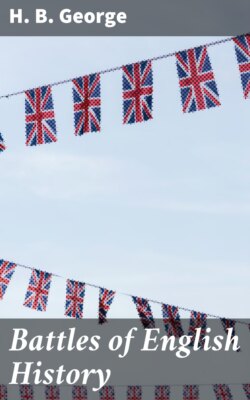Читать книгу Battles of English History - H. B. George - Страница 10
На сайте Литреса книга снята с продажи.
INTERMEDIATE NOTE
THE LONG-BOW
ОглавлениеTable of Contents
The long-bow is like many other inventions which have played a great part in history: its origin is obscure. The bow in some form is almost as old as the human race; but it on the whole was regarded as the weapon of inferior soldiers, down to near the time when the invention of gunpowder was destined to render it altogether antiquated. We have seen that the Norman archers at Hastings, skilfully used, contributed greatly to the victory: but the evidence of the Bayeux Tapestry may be taken as conclusive that these bows were only the short bows of the ancient world. Richard I., the only really warlike king between the Conqueror and Edward I., took pains to introduce the cross-bow, then a comparatively new weapon.[18] It is incredible that the ablest soldier, as Richard undoubtedly was, even of an ignorant age, should have preferred the cross-bow to a weapon which could beat it at every point. Hence we must conclude that the feats of archery attributed to Robin Hood, Richard's contemporary, were reflected back upon his memory from a later time, when such feats were no longer impossible. In the Barons' War the archers play no important part; but in the course of the reign of Edward I., the long-bow came into general use. Edward used his archers with such effect at Falkirk, that it may fairly be inferred that he had long before seen the value of the long-bow and taken steps to foster the use of it, though even then they were employed as an afterthought, to help the horsemen, who alone could not break the Scottish spears. There is nothing like clear evidence as to the locality which developed the long-bow, which not only exceeded the older bows in size and power, but was used in a different manner, though there are slight indications suggesting that South Wales had that honour. At any rate in the fourteenth century it was the familiar and trusted weapon of the English, the instrument of their great and repeated victories.
Archery, as an amusement, has lost much of its popularity of late years, being superseded by other sports which demand less space and afford more active exercise. Probably however every Englishman, if a bow were put into his hands, would instinctively draw it more or less in the right fashion, whether he has ever seen an arrow shot off or not. That is to say he would hold it upright, and draw the string back on his right side, standing himself sideways. Before the introduction of the English long-bow, all archers held their bows more or less horizontal, and drew the string to their bodies. The advantages of the English method are probably obvious: at any rate the briefest experiment will render them so. First, a much longer bow can be drawn to the side than to the breast, which enables a longer and therefore more powerful arrow to be used. Secondly, a much stronger bow can be pulled in that way, which means greater penetrating force. Thirdly, if the long-bow is drawn correctly, the arrow is brought up close to the right ear, which enables the archer to look along the arrow, and aim it with considerable accuracy, whereas obviously no arrow drawn to the breast could be really aimed. Practice makes perfect, in archery more than in many other things: the English archers of the fourteenth century practised assiduously, and attained corresponding proficiency. The regular practising distance was a furlong,[19] which implies that arrows discharged at a high elevation would travel much further. In fact we find "a bow shot" used as a rough measure of distance, equivalent to about 400 yards. If they struck armour obliquely, of course they would be likely to glance and not penetrate; but it required the very best steel to stop an arrow which struck full and true. Add the fact that a trained archer could shoot with astonishing rapidity, so that the arrows in their flight dazzled and bewildered the enemies at whom they were aimed, and still more their horses: and we have the picture of a missile weapon unequalled till the introduction of the rifle.
Why the long-bow should have remained, as in fact it did, the exclusive property of the English, is a mystery. It is true that archers could not stand alone: they required the assistance of troops differently armed, to protect them against determined attack by mailed horsemen in adequate numbers. It is true also that the long-bow needed considerable muscular strength for using it; and the average Englishman had probably the advantage in this respect over the average Frenchman, then as now. But Lowland Scots are to all intents and purposes of the same race, yet they went on generation after generation losing their fights large and small against the English, chiefly through the archers, yet never learning to shoot. The explanation may perhaps be that among all who came to feel the power of the clothyard shaft, feudal pride was too stubborn to be taught quickly, so that gunpowder was coming into use before they had digested the lesson. Whatever the cause, the fact is certain that the English kept their monopoly of the long-bow, and consequently were, for a century at least, supreme on the field of battle.
